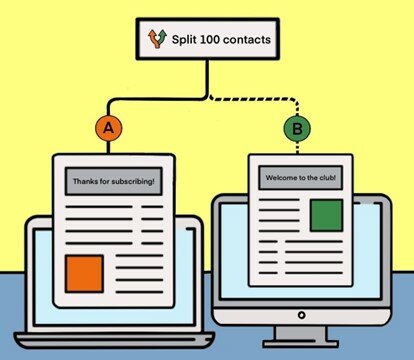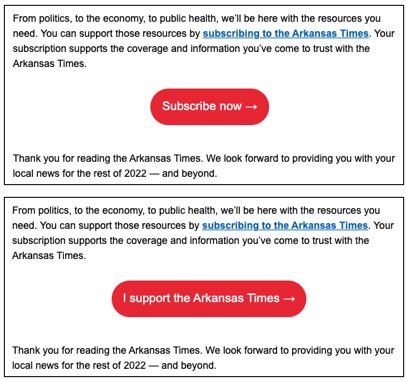Christine Holbert, Audience Engagement Manager | BlueLena
Posted Thursday, July 20, 2023 6:28 pm
Tips for building an effective landing page (and a few things not to do)
 IntroductionWhat’s A/B testing and why should I use it?
IntroductionWhat’s A/B testing and why should I use it?A/B testing is a data-driven way to determine what content, format, or other variable works best for your audience.
Not sure when to send a new newsletter? Test different send times. Wondering if including an image affects the performance of your fundraising campaign? Send a version with and without an image to random samples of your audience. Want to know what kind of subject lines draw in your audience? Split test different options.
A/B testing can be done on almost any element of your campaign: subject lines, CTA buttons, images or graphics, sender name, send day and time, etc. (On BlueLena’s platform, you can test up to five variations of an email at a time.)
Can you give me an example?In the summer of 2022, BlueLena ran a seven-email reader revenue campaign. Five newsrooms who used the customized messaging also participated in A/B testing on subject lines and CTA buttons. The five participating newsrooms sent to over 155,000 contacts through the course of the campaign.
From that campaign, we identified five tips for A/B testing your email campaigns:
Can you give me an example?
In the summer of 2022, BlueLena ran a seven-email reader revenue campaign. Five newsrooms who used the customized messaging also participated in A/B testing on subject lines and CTA buttons. The five participating newsrooms sent to over 155,000 contacts through the course of the campaign.
From that campaign, we identified five tips for A/B testing your email campaigns:
1. Personalize your subject linesSubject lines are our first chance to engage our readers over email, and a successful subject line will stand out in the inbox and encourage the reader to open. There are many ways to craft a unique subject line. One way is to personalize your subject lines by introducing the email author or using the personal “I.”
Example

In this test, we tried a personal introduction with a generic subject line. In A, the reporter who authored the email says hello to the reader and introduces themselves. In B — without the emoji — the subject line headlines what the email is about.
Here, A outperformed B in every case and increased open rates by 11%. For one publisher, A increased open rates by 35%.
2. Use emojisEmojis project personality and accessibility to readers.
Example

In both cases, the subject line with the emoji performed better than the subject line without the emoji.
Generally, emojis are placed at the beginning of the subject line. However, if your subject is under 50 characters, you can add the emoji to the end of the subject line. In a longer subject line, the final characters will be cut off in most inboxes, and the emoji will not be seen by the reader.
3. Craft a first-person CTAYour call-to-action (CTA) button can make a major difference in your conversion rate. You can test the text, color, size, shape and language of your CTA button to see what works best for your audience — though test one element at a time so you can differentiate between results.

Example
CTA A: Donate now
CTA B: I support
A relies on urgency to convey the call to action: Donate now.
B uses the personal “I” to insert the reader into the text.
In three out of five campaigns, “I support” outperformed “Donate now.” That personal “I” resonated with readers.
For one publisher, “I support” improved their click rate to .70%. (The average click rate in fundraising emails in 2022 was .54%.)
4. Add urgencySee if your readers need a sense of urgency to encourage them to donate. Try “Subscribe now” or “Subscribe today” over “Subscribe.”
There are other ways you can add urgency: give a deadline, e.g. “Subscribe before our fiscal year ends;” share a motivating reason, e.g. “Donate today to have your gift matched;” combine urgency with personalization, e.g. “I’ll donate right now.”
5. Send from the teamWe’ve established that personalization leads to success. That can be personalization for your reader, like using the personal “I” in CTAs, or it can be personalization from the publication, like introducing a reporter in a subject line.
What if you want to personalize your message from your organization but don’t have one name to attach or capacity for one reporter to write a message? Try sending a message from the team to create a sense of community.
Example
Subject line A: Keep strong this summer
Subject line B: We won’t take a break from covering the news you need
As you can guess, B outperformed A. It created a direct line from the organization to the reader. A, while assertive, did not result in as high of an open rate.
About BlueLena:BlueLena was founded by a team of experienced newsmedia executives to create a sustainable future for independent local media through building and supporting subscription, membership and donation models for long term-success. Today, over two hundred brands leverage our audience management platform, strategy consulting and marketing services to accelerate their digital transformation.
Source: Editor & Publisher Magazine
Original Content: https://shorturl.at/hxS04